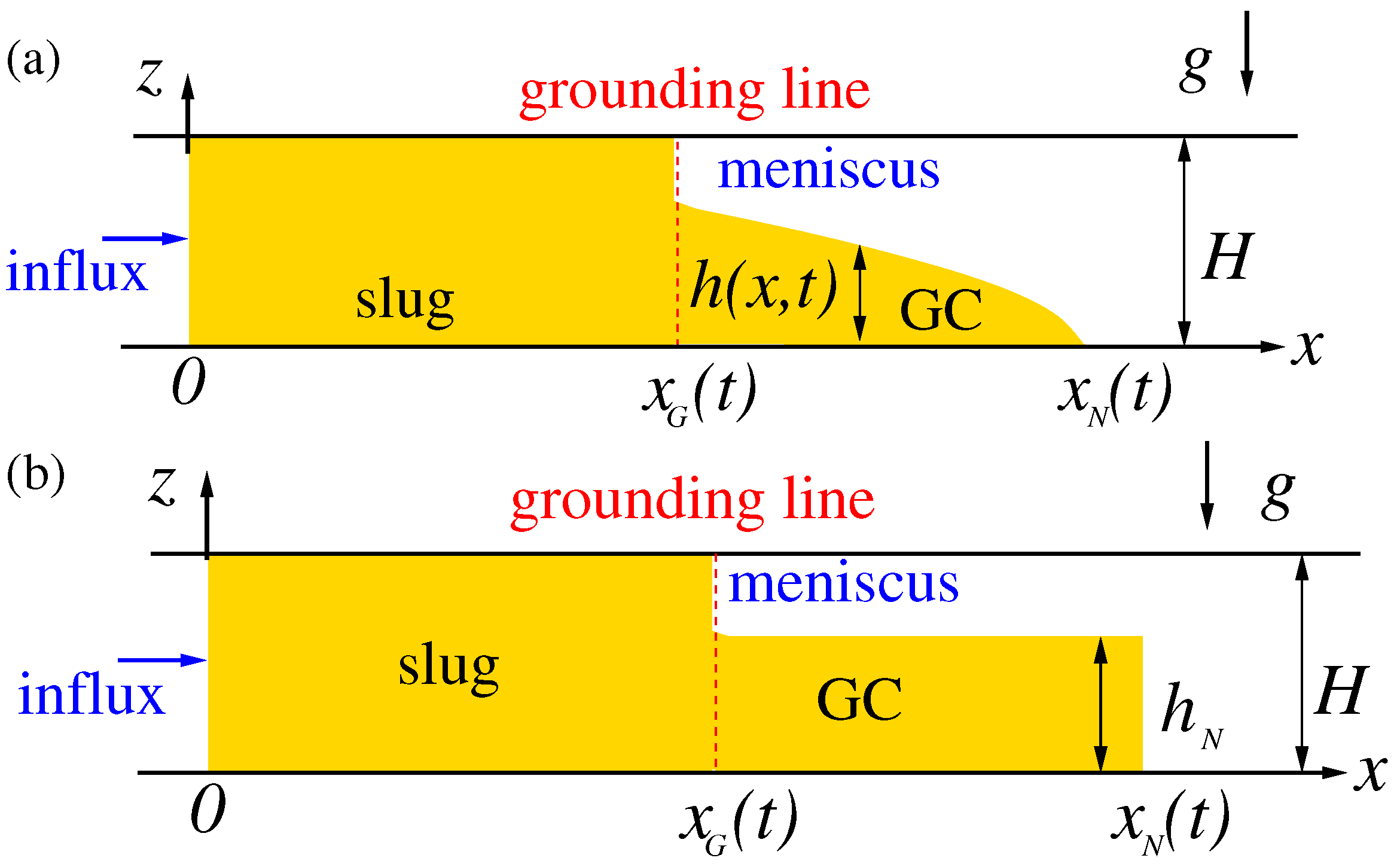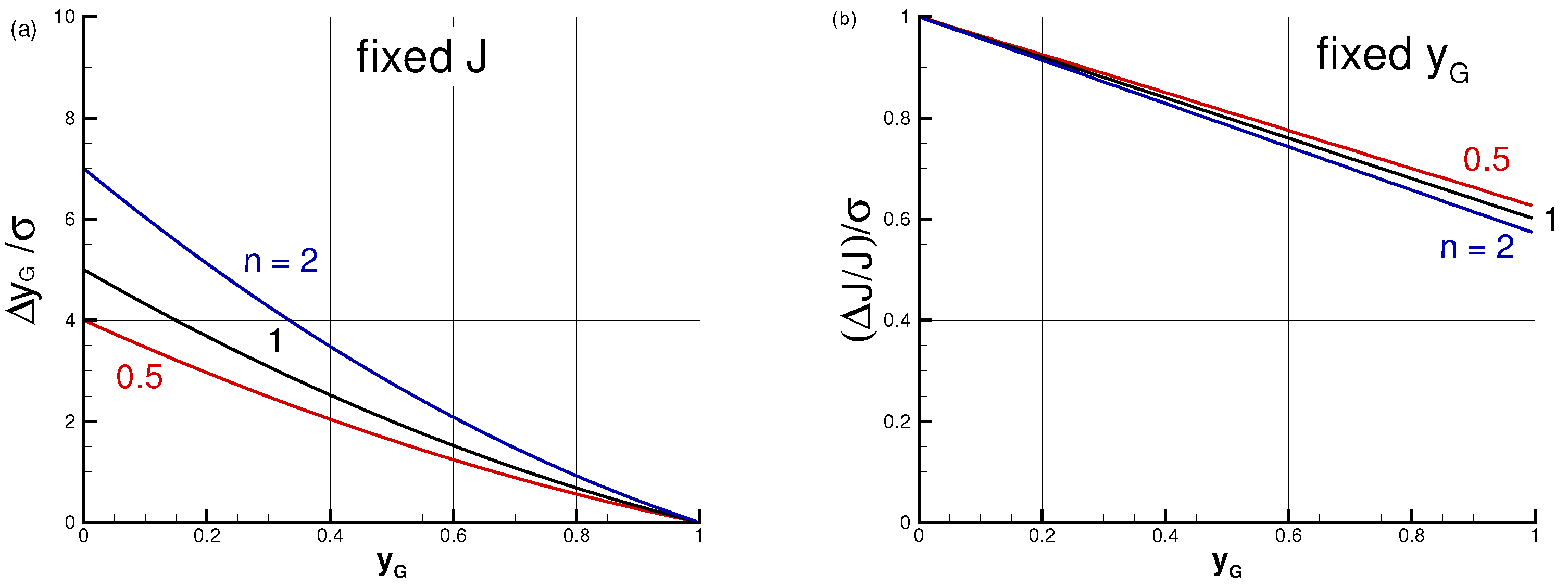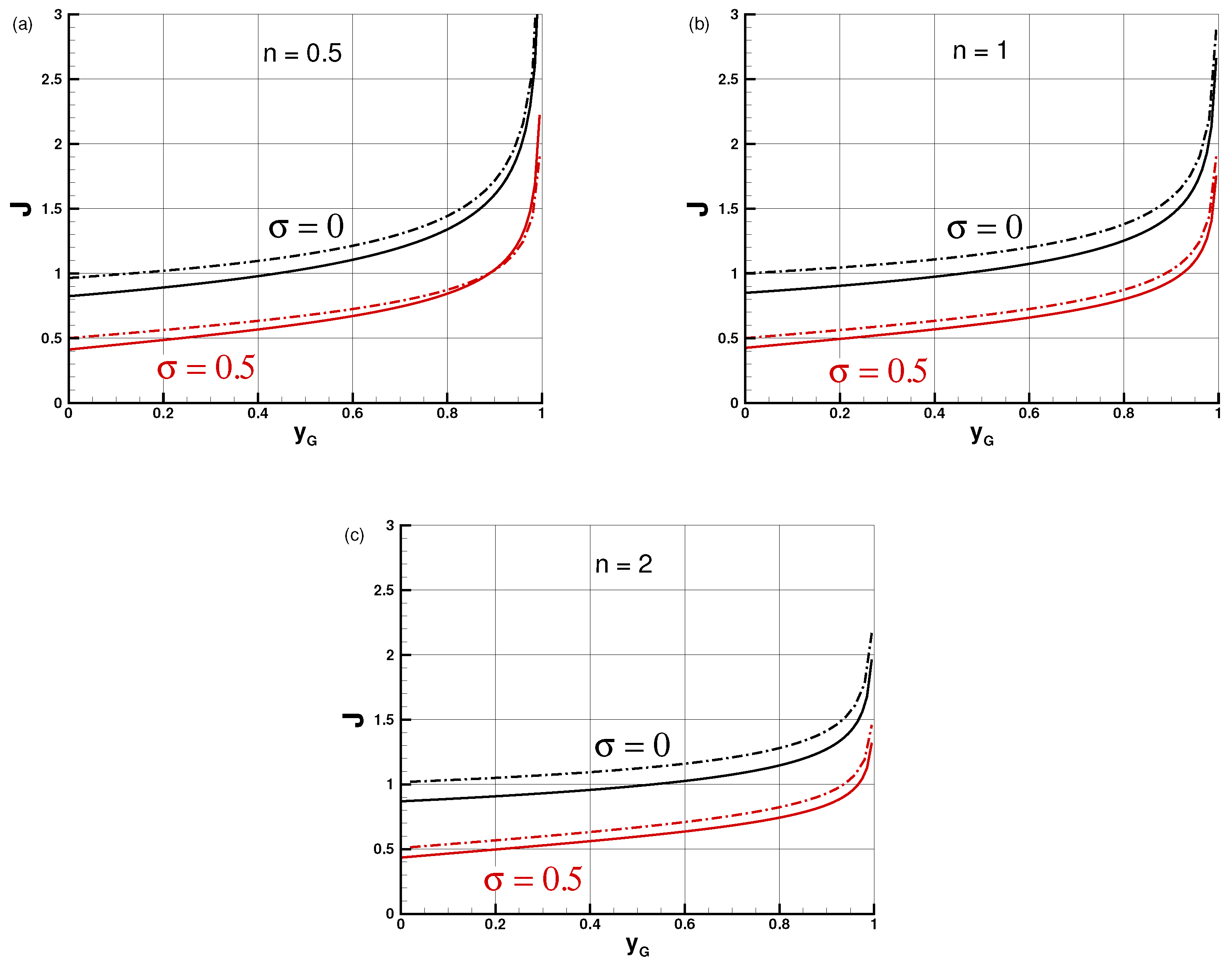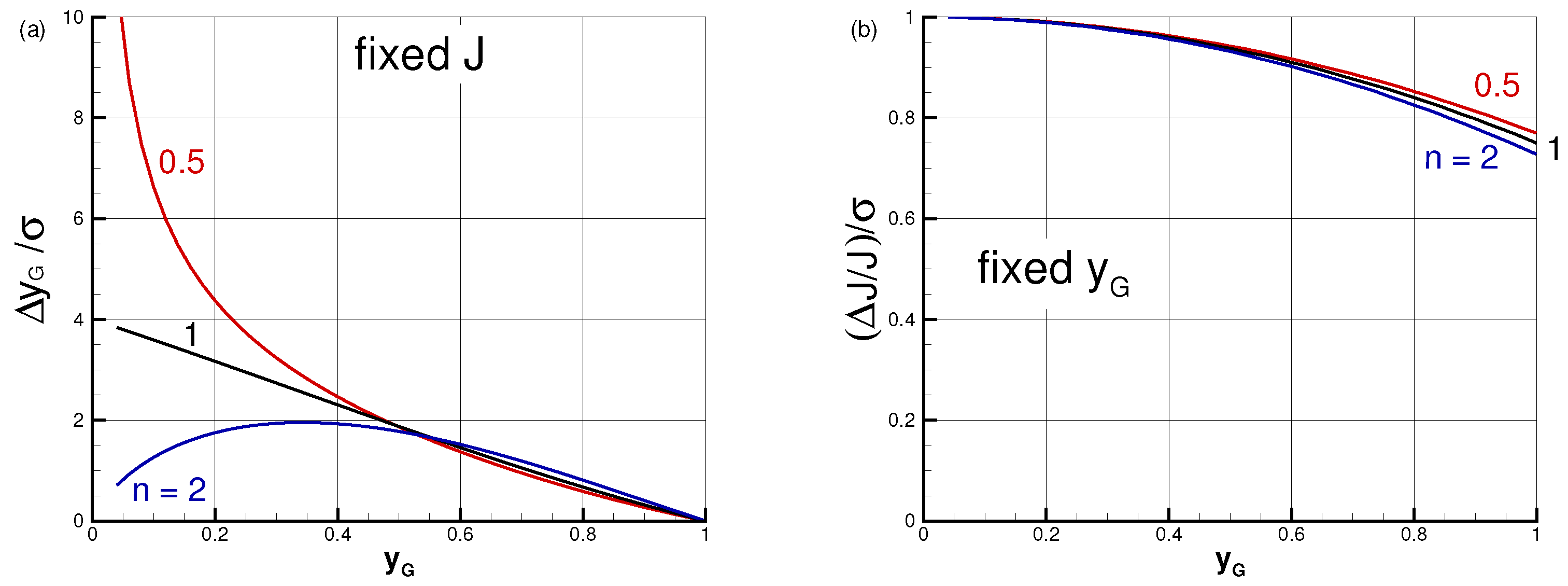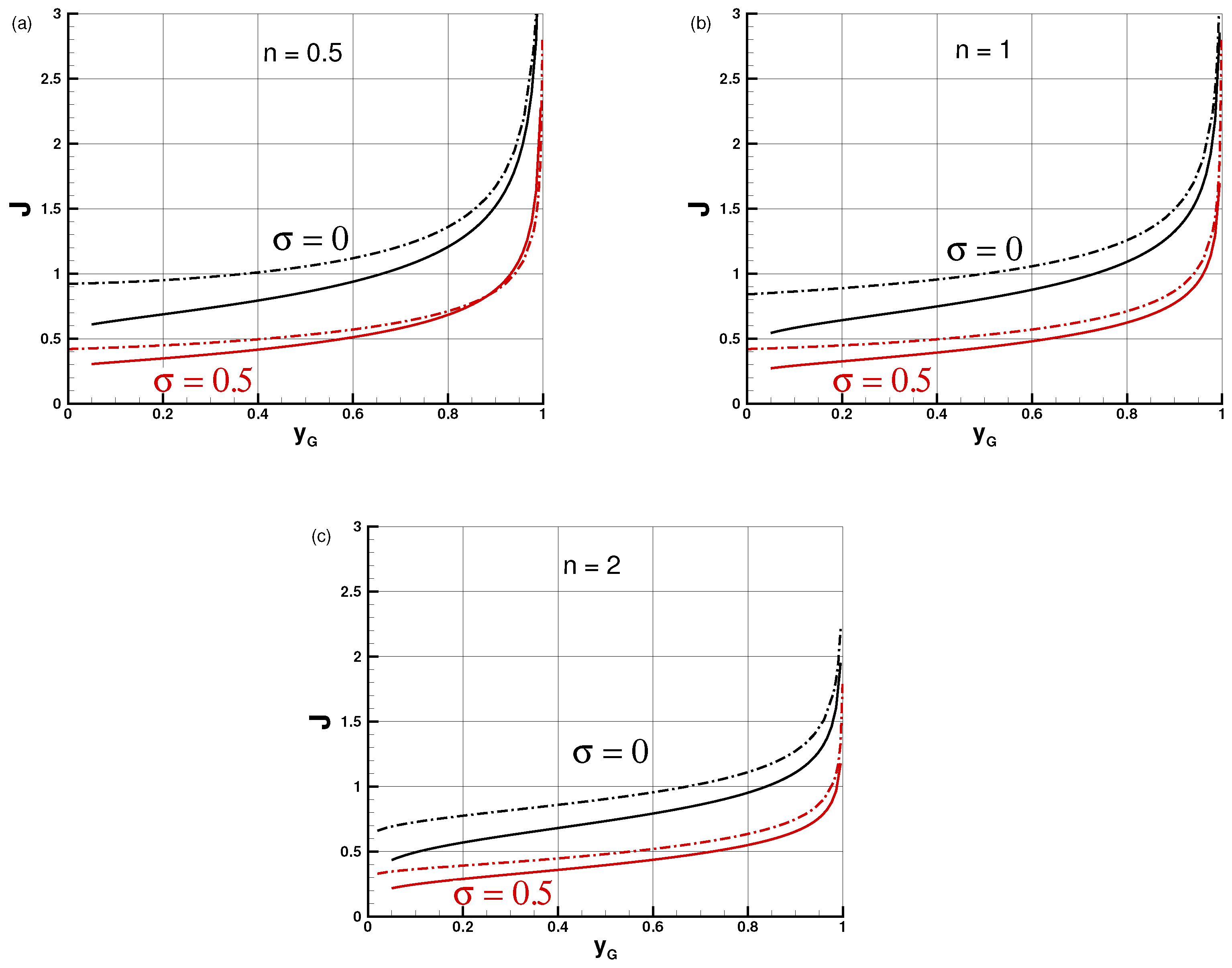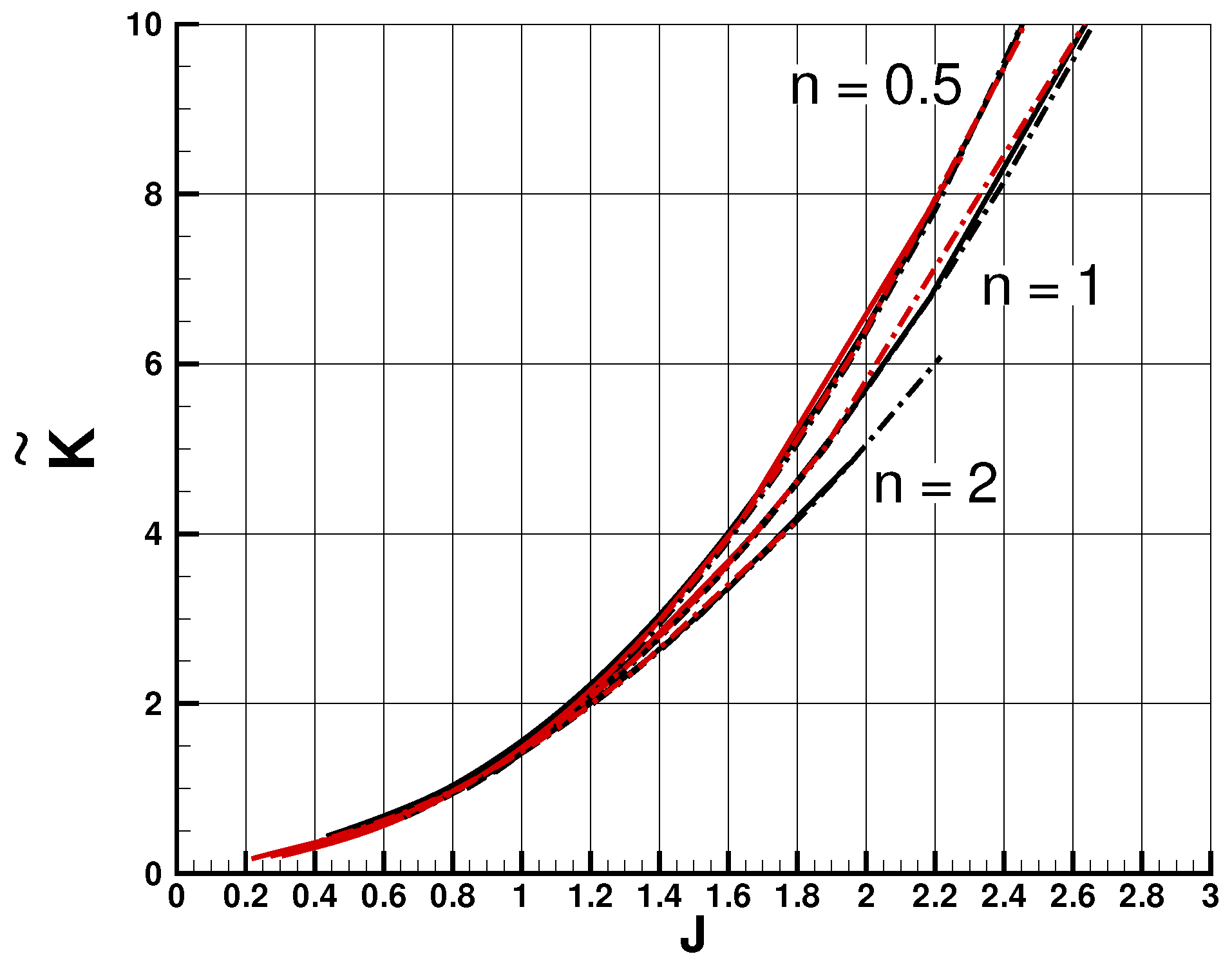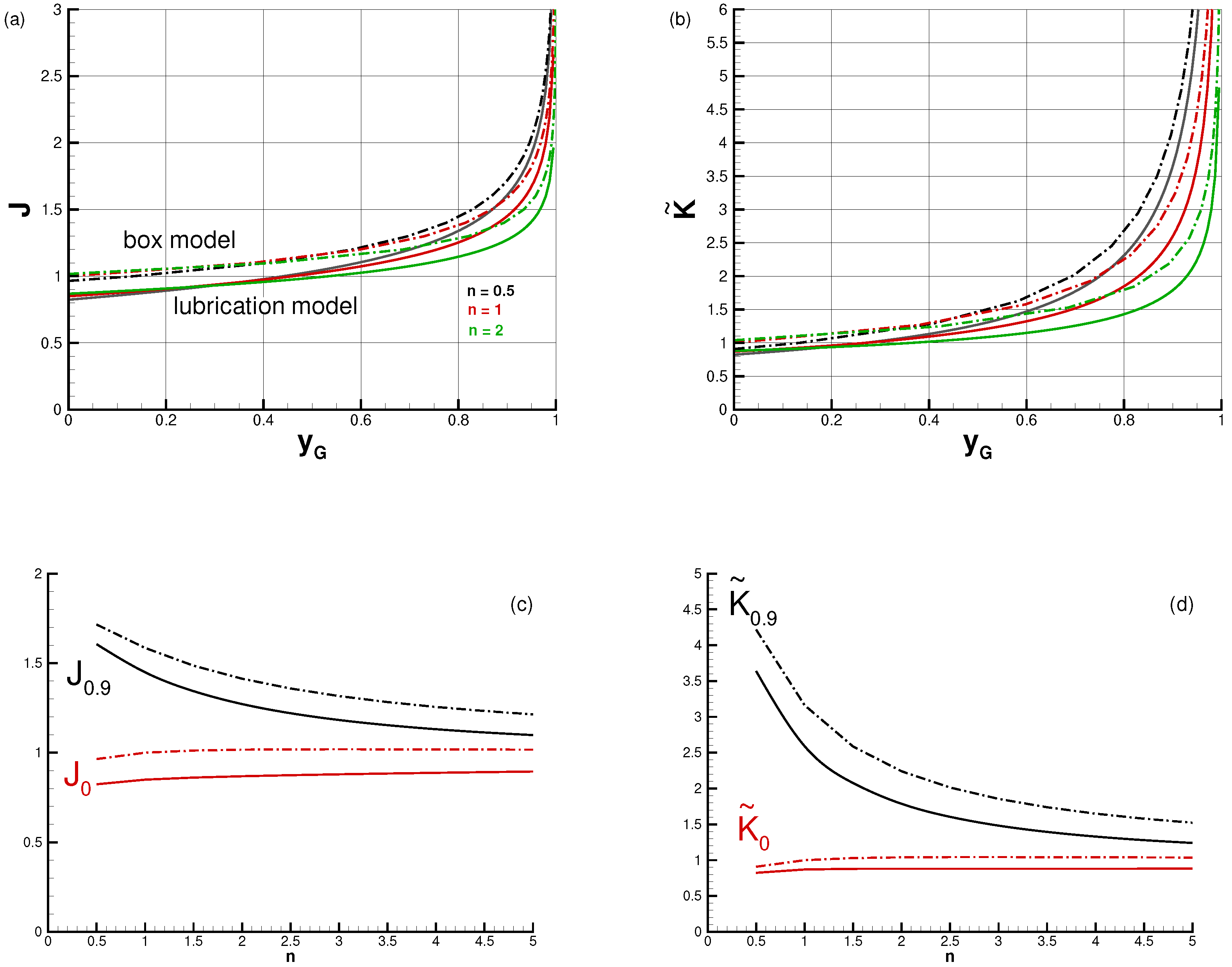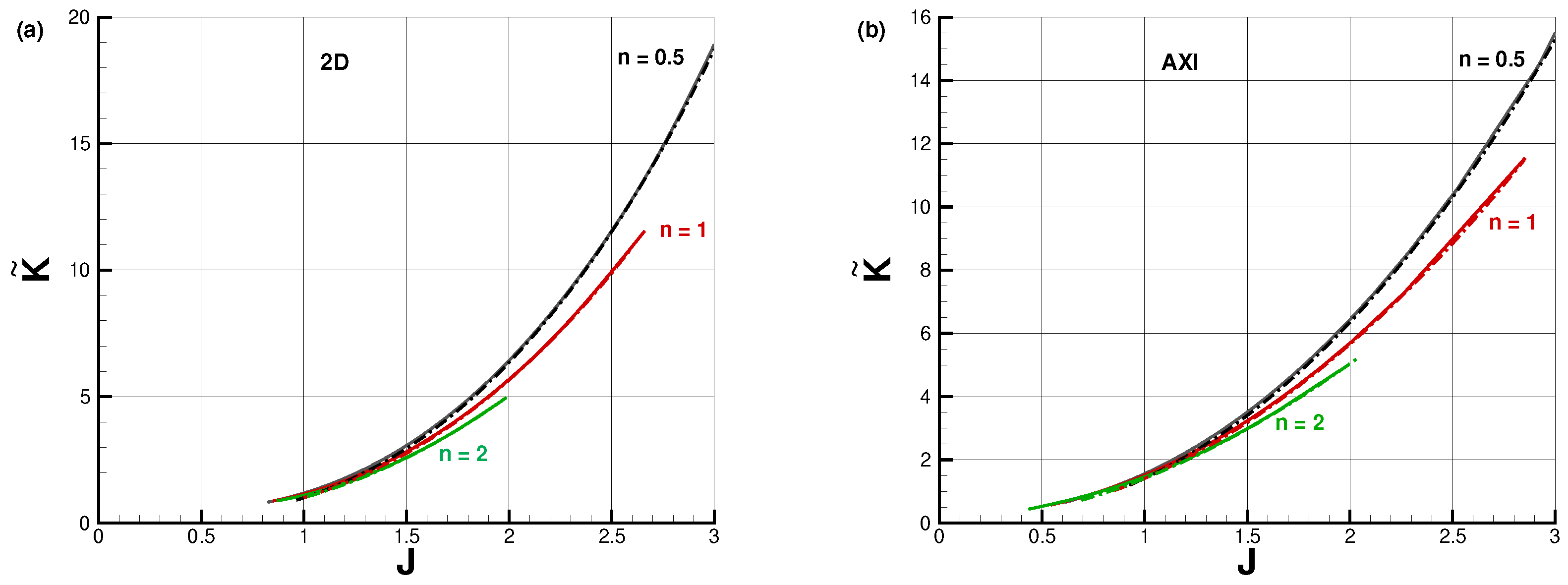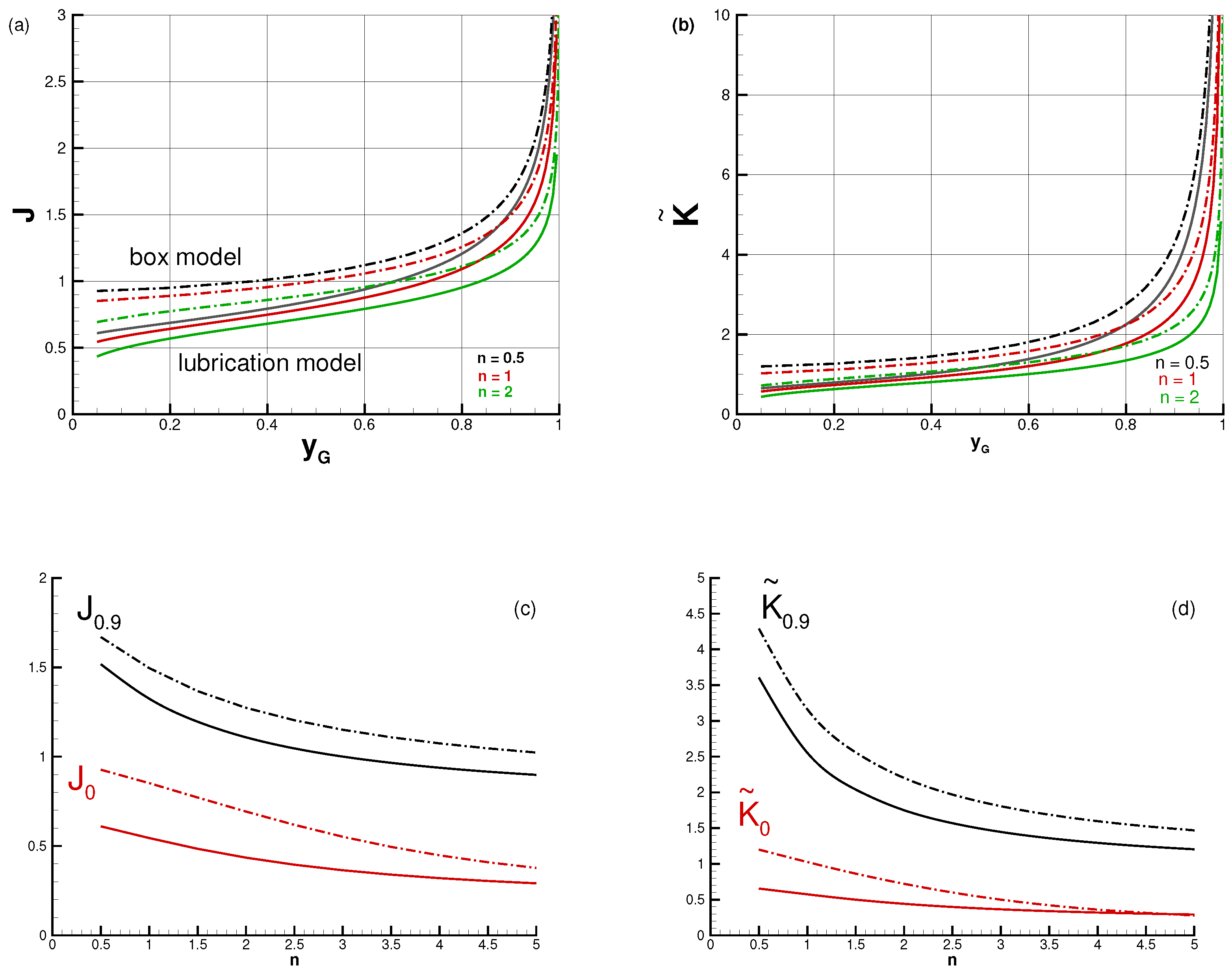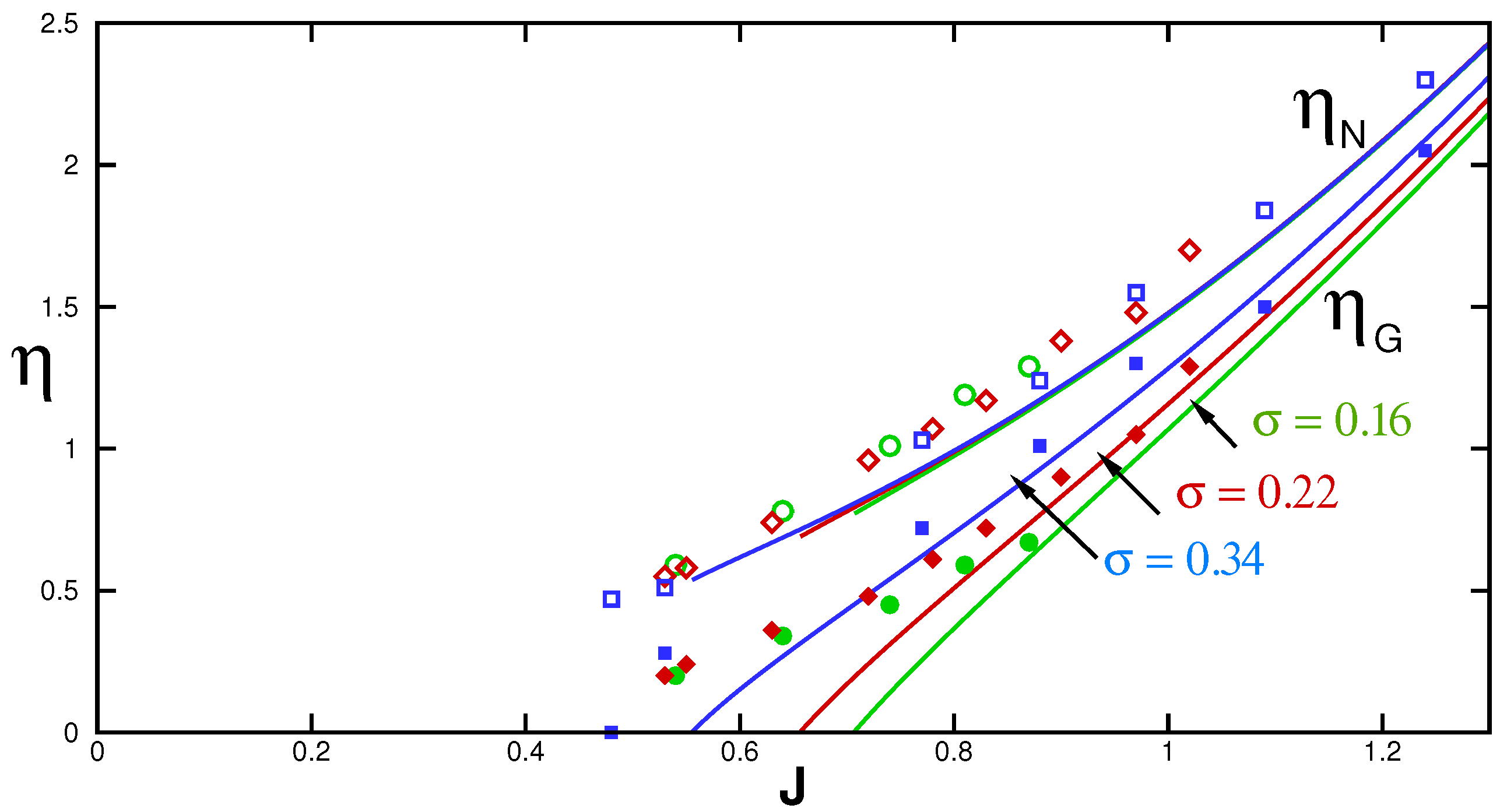1. Introduction
Gravity current (GC) is a generic name for the buoyancy-driven flow of a fluid of one density,
, into an ambient fluid of a different density,
. The propagation of the GC is mostly in horizontal direction
x (to be distinguished from the mostly vertical buoyancy-driven flows called plumes); see [
1] and the references therein. The driving buoyancy mechanism is explained as follows: the hydrostatic pressure fields
produce a horizontal pressure gradient
, where
g is the gravitational acceleration,
z is the vertical upward coordinate,
j denotes the ambient and current, and
is the reduced gravity. The buoyancy is balanced by inertial or viscous effects. Here we consider the so-called viscous GC, dominated by a buoyancy–viscous dynamic balance, relevant to flows at a small Reynolds number. Viscous GCs have numerous applications in nature and industry. The systems of interest belong to various prototypes, such as Newtonian or non-Newtonian fluids, two-dimensional (2D) or cylindrical axisymmetric (AXI) propagation, fixed or time-varying (influxed) volume, liquid or porous medium. An important distinction is between unconfined and confined (gap) domain into which the GC propagates. Geostrophic and environmental GCs are often unconfined (e.g., spread of lava or oilspills), and have received significant attention.The confined GC occurs often in a gap where one viscous fluid displaces another viscous fluid in particular in the context of porous layers (e.g., [
2,
3,
4,
5] and the review [
6]).
Recent investigations addressed the flow of confined viscous GCs, relevant to injection molding (see [
7]); see
Figure 1a. Consider the two-dimensional (2D) propagation of a viscous fluid injected into a small gap of height
H between two horizontal plates. This system is a simplification of a realistic rectangular channel of width
. We assume that the ambient fluid, displaced from the gap by the injected fluid, is less dense and significantly less viscous than the injected one (e.g., oil injected into air). In this case, the following type of flow may appear: the dense fluid forms a slug that fills the gap in
, while the fluid ahead of the slug, in
, forms a viscous GC on the bottom while the interface is detached from the top of the gap. The subscripts
G and
N denote the “grounding line” and the nose of the GC. Moreover, when the injected volume is
, such flows may be self-similar, in the sense that the GC elongates like
while the slug elongates as
, where
are positive constants and
t is time. (The details of the source at
are outside the scope of this study. In the laboratory and industry, the influx is supplied by a pump or similar mechanical device, which provides the volume rate and the pressure necessary for the flow in the
domain. There is evidence that such systems work well, i.e., [
8]).
The stringent task is to determine the values of , and K for a given physical system. Moreover, it is important to suggest a convenient scaling to determine the governing dimensionless parameters and predict the trends of the flow upon the variation of the input conditions. In particular, it is clear that for a sufficiently large H, the confined GC can be considered unconfined; a sharp criterion for this transition is of interest. The need for an efficient prediction method motivated our study.
Ref. [
8] considered the confined axisymmetric (AXI) flow of a Newtonian fluid (theoretically and experimentally). They used a lubrication-theory model (with no surface tension effects) to show that a constant influx,
, produces self-similar propagation with power
, and the only governing dimensionless parameter is
, where
l is the typical height of the corresponding unconfined GC. The associated experiments (using golden syrup in a gap of about 1 cm filled initially with air) supported the theory (with some small discrepancies). Ref. [
9] (referred to below as U25) extended the theory to cover also two-dimensional (2D) and non-Newtonian power-law fluids with exponent
n (the Newtonian fluid is recovered for
). The lubrication-theory framework indicates that a self-similar flow develops for select values of
, determined by
n; the power
is equal to
in 2D case and
in AXI case. The detached interface of the GC displays an inclined profile (see
Figure 1a) which is defined by a second-order ordinary differential equation subjected to boundary conditions at the nose and at the grounding line, which, in general, must be solved numerically. When surface tension effects are discarded, for a given fluid (specified by the viscosity exponent
n), the scaled solution depends on only one dimensionless parameter,
J. The theory provides a convenient scaling of variables, and a sharp prediction of the threshold value
below which the confinement is irrelevant (the GC with the select
propagates on the bottom without touching the top of the gap).
The paper [
10] revisits the system of [
8], and it demonstrates that the discrepancies between theory and experiment can be attributed (mainly) to surface tension (
) effects between the current and the ambient fluids at the grounding line. The Young–Laplace formulation predicts the existence of a meniscus at the grounding line of height of the order of the capillary length
, but the details and boundary conditions are complicated and hence an accurate solution of the meniscus in practical systems is not feasible. However, by modelling this meniscus as a vertical jump of height
(see
Figure 1, where
is a constant) the surface tension effect was added conveniently to the original lubrication-model. The main point is that the similarity behaviour is maintained, with unchanged
and
. The dependencies between
, and
K are affected by
. The theoretical solutions with small
show better agreement with experiments than the original
predictions. Although the exact value of
is not known a priori, this model provides valuable insights and can be applied with tentative theoretical or empirically estimated values. The study of [
10] suggests that
is a fair approximation. This promising extension of the original lubrication model similarity solution was derived and tested in [
10] only for the a Newtonian fluid in AXI system (
). Here we show that the
contribution can be also implemented conveniently in the theory of confined GCs of power-law fluids in both 2D and AXI systems.
The advantage of these published theories, based on the lubrication simplification, is the rigour of the governing equations and of the mathematical solution. The similarity solution predicts analytically the time behaviour, but the spatial profiles must be compiled numerically. The numerical task is straightforward. The disadvantage of this solution is that the needed mathematical manipulations are cumbersome and the results lack analytical description. This precludes straightforward extraction of trends and obscures the physical insights. This difficulty is exacerbated for the confined flow of power-law fluids in the presence of surface tension effects, which is dependent on three major parameters, , and the geometry (2D and AXI). (An additional parameter, , associated with the nose meniscus, will be introduced later). For example, the value (for a given ) is obtained from the numerical integration of a second-order ODE; a change of requires a new integration. This motivated the search for a simpler mathematical model for the same physical problem.
A simpler model is expected to be beneficial for both research and applications. For this objective, in this paper, we develop and test a box-model solution. The box-model approximation makes bold assumptions about the details of the local behaviour of the flow field, and it applies integral balances of volume and momentum on the entire mass (the box) of the GC. Box models have been used successfully for influxed viscous GCs, but, to our knowledge, only for unconfined systems (e.g., [
1,
11,
12,
13,
14,
15]). A widely used simplification (also implemented here) is that the interface of the GC is horizontal, as seen in
Figure 1b; this eliminates the calculation of the profile of the inclined interface, which is the major challenge in the lubrication model.
The present work is a significant extension of the improved box model presented in [
15]. The previous model considers GCs in a very deep environment, i.e., the height of the container,
H, is much larger than the height
h of the current. In this configuration, called “unconfined,” the GC that propagates on the bottom is not influenced by the top boundary. In the present system, the GC is confined by the top. Moreover, here we take into account the surface tension effect, because there is evidence ([
10]) that the meniscus about the grounding line in the confined flow affects the motion (see
Figure 1). In other words, the present box model incorporates two novel physical effects: confinement and surface tension. The present paper demonstrates that the box model for the self-similar confined flow provides explicit simple and insightful results for both 2D and AXI systems with Newtonian and non-Newtonian power-law fluids, including surface tension effects.
The surface tension is expected to generate, in addition to the meniscus at the grounding line, a meniscus at the nose as well, i.e., a modification of the tip of the GC at the bottom position
in
Figure 1a. This effect can be incorporated in both the lubrication and box models with an additional small parameter
. However, the typical influence of this meniscus is significantly smaller than that of the grounding-line meniscus, and hence the main analysis and discussion of the paper ignore this detail. The quantitative justification will be given in
Appendix A.
The structure of the paper is as follows. The box-model-governing equations are developed, and some useful analytical results are derived for the general system (including surface tension), for the 2D and AXI systems in
Section 2.2 and
Section 2.3, respectively. Results for the special (basic state) with excluded surface tension,
, are presented in
Section 3. At the end of each section, we perform stringent quantitative comparisons with the more rigorous lubrication-model solution and show that there is good agreement for a wide range of parameters. A brief comparison with published data is discussed in
Section 4. Concluding remarks are given in
Section 5. The effect of the nose meniscus (not included in the main text) is estimated in
Appendix A. The method of solution of the lubrication model, which is compared with the box-model predictions, is briefly presented in
Appendix B.
4. Comparison with Data
A useful test for the validity of the box model is provided by a comparison of the present predictions with the experimental data presented in the papers of [
8,
10]. The laboratory system is AXI, the GC fluid is Newtonian (
) golden syrup, the ambient fluid is air (hence
), the gaps
H are 0.71, 1.07, and 1.48 cm. The viscous fluid was influxed at a constant rate (
) by a piston pump via a hole of 5.5 cm in diameter in the bottom plate and spread out in a quite axisymmetric pattern (the maximum
was 27 cm). For sufficiently large influx rates, a clear separation between the slug and the GC, i.e. a clear grounding line, was observed. The propagation of the nose
and grounding line
(when present) were recorded for various constant volume fluxes. The absence of the grounding line indicates a free (unconfined) GC.
Refs. [
8,
10] use the same scaling as that used here for length, velocity, and time (see (
23)) but employ the notations
and
as follows:
In terms of our scaled solution (see (
40)) the correspondence is
,
,
.
The definition of
J here (
37) for
recovers the definition of
J in these papers.
The box model predicts that for
, a self-similar propagation of the type (
46) appears in the AXI system for
. The experiments confirmed this prediction: the measured
and
fit that pattern very well. This allowed the calculation of the experimental
and
(the estimated error is
; the error of the experimental
is 22 %).
Table 1 of [
8] provides values of the experimental
and
as functions of
J for three different gaps
H. Ref. [
10], using available experimental values of the surface tension
, pointed out that the three different gaps
H also imply three different values of the parameter
. The suggestion is to use the approximation
in the models. Figure 4 of [
10] shows the experimental points
and
vs.
J (symbols), as well as the corresponding predictions (curves) of the lubrication model, which takes into account the surface tension effect.
The box-model predictions for the tested flows are straightforward. For the AXI system with
, we obtain
, (see (
27) and (
33)). For a given
, the algebraic Equations (
34) and (
40) provide values of
and
for various
J of interest. Using these results and the conversion
, we present in
Figure 11 a similar plot to Figure 4 of [
10]. The the lines are box-model predictions. There is a fair agreement of the predictions with the data. We see that the model predicts correctly the behaviours of
and
. There is strong decay of
as
J decreases from 1.2 to 0.5 (approximately). However, the effect of
on this variable is remarkably small: the theoretical lines for the three values of
almost overlap, and the open symbols for the three values of
collapse on a smooth (imaginary) line.
decreases faster than
as
J decreases.
increases with
, as seen in the prediction lines and in the filled symbols. (For
, the comparison with data is irrelevant because the GC is unconfined).
The box model provides the physical interpretation of these trends. The parameter
J is proportional to
. When the influx rate decreases and/or the gap increases, the parameter
J decreases, and in the physical system, the coefficients
and
of the propagation of the fronts (see (
46)) are expected to decrease due to volume conservation. A larger
cause a smaller effective thickness
(see
Figure 1b) and a smaller buoyancy force
. This allows a reduction of the bottom drag of the GC which is
. Consequently, at a fixed
J, a larger
appears for a larger
. The behaviour of
is subtle. For a fixed
J (fixed influx), a larger
renders a smaller effective thickness
; this would suggest an increase in
to accommodate the volume. Here enters the second front. The larger
increases
, which means an increase in the radius of the slug. The larger slug absorbs a larger portion of the influxed fluid and counteracts the expected increase in
. The resulting flow displays a value of
, which is minimally affected by the variations of
in these data.
The quantitative discrepancies between the data and the theoretical predictions observed in our
Figure 11 are, roughly, of the same magnitude for the present box model and the lubrication model used by [
10] (Figure 4 in that paper). It is not possible to determine how much of the discrepancy is attributable to the box-model simplifications, because of the restricted data set, experimental errors, and uncertainty of the parameter
. Taking into account the fact that the box model predicts correctly the values of
and
of the experimental system, the overall predictions of the box model in this test seem to capture well the physical balances of the flow under consideration. In our opinion, this comparison provides support to the box model as a predictive tool for realistic systems, and motivates further tests in other systems, particularly power-law fluids.
5. Conclusions
We presented a box-model analysis of the flow of a viscous fluid injected into a horizontal gap of height H in rectangular 2D and cylindrical AXI geometries for a power-law non-Newtonian fluid (). When the displaced (ambient) fluid is less dense and significantly less viscous than the injected one (a typical occurrence in molding industry), and the influx is sufficiently strong, the leading part of the flow is a GC while the tail fills the gap. We focused attention on the influxed volume . We showed that for certain values of (depending on n), the flow is self-similar: the propagation of the nose and of the grounding line are like and . In general, in 2D and in AXI. We recall that the unconfined GCs display self-similar propagation for any . The confinement restricts the similarity flow to and in 2D and AXI flows, respectively. We obtained explicit formulas for the stringent features of the flow field, like . All the results are in good agreement with the more rigorous lubrication-model solution (which does not assume a horizontal interface). In particular, we note identical prediction for the time-power coefficients and , as well as a surprisingly small discrepancy for the dimensionless prefactor .
In general, the flow under consideration depends on four parameters: , and . The box model demonstrates that the dependencies are strongly coupled and non-linear, and hence a simple model is helpful for understanding the physical influence of each of the parameters.
The box model reveals that the main surface tension effects, , are as follows: (a) for a fixed J, the position increases; (b) for maintaining a fixed , J must be reduced. The effects of a nose meniscus are in the same direction, but .
The restriction of the solution to special values of the influxed volume coefficient
reproduces a physical condition, not a mathematical simplification. We argue that the similarity behaviour corresponding to this
is essential in the present problem; influx with a different
is bound to produce a very different flow pattern. The present
keeps the grounding line between the inlet and the nose (
). In this case, the GC elongates, but maintains a constant average thickness. When
is reduced, the GC tends to become thinner with
t, the grounding line moves toward the inlet, and an unconfined GC appears on the bottom of the gap. When
is increased, the GC tends to become thicker with
t, the grounding line moves toward the nose, and all the injected fluid behaves like a slug in contact with both boundaries of the gap. It is remarkable that the similarity solution is robust: for a given geometry, the time powers
and
depend on
n, and are unaffected by the presence of surface tension effects represented by
and
. This interesting prediction has been verified experimentally for the AXI system and
([
10]), and further tests will be beneficial.
We recall that the accurate value of the surface tension parameter
is not available for practical systems. The comparisons of predictions with data, performed by [
10] and here in
Section 4, suggests that
is a fair approximation. This is a good starting point for the practical use of the present models. However, we must keep in mind that the data set of [
10] covers only AXI flow of a Newtonian fluid. For the assessment and improvement of the extended theory, a much wider experimental study is necessary. We expect that this will be reported in the near future.
The advantage of the box model is in the simplicity of the derivation and the predictions. We straightforwardly gain the insight that the kinematic (volume continuity) balances determine the relation between and , as well as the coefficient K; the dynamic force balance determine the values of and . The interconnections between the dimensionless variables are expressed in explicit formulas, without any adjustable constants. The description of the flow has been reduced to a set of basic algebraic-substitution formulas. The influence of the surface tension meniscus at the grounding line (parameter ) is well elucidated. The box model also clarifies that the effect of the nose meniscus (parameter ) is typically negligible. These simplifications are expected to facilitate the analysis and design of various applications. Needless to say, the same information can be extracted from the more rigorous lubrication model, but this requires a more significant effort of programming, data processing, and interpretation.
We emphasise that, in general, the box model is an unreliable prediction tool, unless subjected to stringent verification against some more accurate results over a significant range of parameters. The present box model can be recommended because it has passed such tests (without using any adjustable constants), and we have reliable information about the expected error concerning the sign (under/over prediction) and order of magnitude. However, we keep in mind that this paper compares mostly between two theories based on simplifications (such as thin layer, hydrostatic pressure, sharp meniscus, and well-controlled influx). The convincing assessment of the models requires critical comparison with experimental data. (The comparison with the data of [
10], which is in
Section 4, is encouraging but covers a restricted domain, particularly
). In view of the large number of involved parameters, this is a challenging experimental task. We are confident that the present quite sharp theoretical predictions will facilitate the experimental verification.
